The 2017 Antarctic summer saw an impressive array of expeditions aiming to travel farther, travel faster, or travel more creatively. Some teams saw success while others were met with challenges, poor weather, and time constraints. As Leo Houlding wrote this season “Nothing is easy out here!”. Despite the difficulty of the journey, all of the expeditioners aimed to achieve and further push the boundaries of polar exploration.
Ski Expeditions
Ice Maiden
Route: Leverett Glacier – South Pole – Hercules Inlet
Skiers: Rosanna Baker (UK), Sandra Hennis (UK), Sophie Montagne (UK), Jennifer Stephenson (UK), Natalie Taylor (UK, Deputy Expedition Leader), Nicola Wetherill (UK, Expedition Leader)
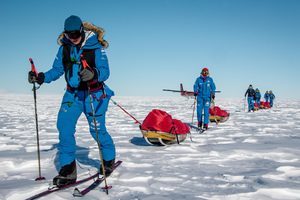
Expedition Ice Maiden, made up of British Army or Army Reserve women, took on one of the most challenging expeditions this year – a transantarctic crossing of over 1,000 miles (1609 km). The team planned only two resupply points, South Pole and Thiel Corner Skiway, and hoped to be the first all-female team to complete the crossing entirely under their own power, without the assistance of wind or vehicles.
The Ice Maidens departed for Leverett Glacier on November 20, after an initial weather delay at Union Glacier Camp. Unfazed by the late start, the team reached the South Pole 26 days later and then continued on in the direction of Hercules Inlet. On January 20, the Ice Maidens skied the final 19 miles (30 km) to Hercules Inlet, completing their goal of an unassisted transantarctic crossing in 61 days.
The Ice Maidens’ journey aimed to raise the profile of women in the British Army and assist with recruitment.
Number of Days in Field: 61 days
Miles Skied: 1,056 miles (1700 km)
Learn More:
exicemaiden.com
The Trans-antarctic Solo Expedition
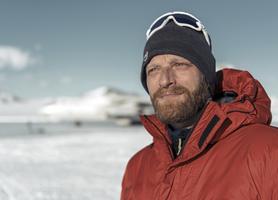
Route: Berkner Island – South Pole – Ross Ice Shelf via the Leverett Glacier
Skier: Ben Saunders (UK)
Ben Saunders is no stranger to polar expeditions, having skied to both North and South Poles. In 2013, he re-traced Scott’s route to the South Pole and back with teammate Tarka L’Herpeniere, setting a world record for the longest ever polar journey on foot. This season Ben set out to complete the first solo, unsupported, and unassisted transantarctic crossing, paying tribute to his late friend Lt. Col. Henry Worsley, who attempted the same feat in 2016.
Beset early-on by miles of sastrugi (frozen wave-like formations in the snow) and poor weather, his forward progress was slower and tougher than expected. He reached the South Pole 52 days and 650 miles (1046 km) later, with only 13 days of food remaining. There Ben made the difficult decision to end his expedition, rather than risk running out of food by continuing on to the Ross Ice Shelf.
Number of Days in Field: 52 days
Miles Skied: 650 miles (1046 km)
Learn More:
bensaunders.com
Bay of Whales – South Pole
Route: Axel Heiberg – Bay of Whales – South Pole
Skiers: Astrid Furholt (Norway), Jan “Sivert” Sivertsen (Norway)
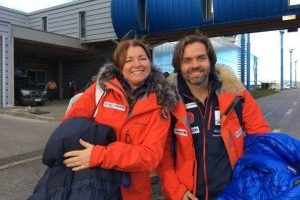 Astrid Furholt and Jan Sivertsen teamed up to tackle one of the most complex and challenging routes of the season. Their goal was to ski the original Roald Amundsen route from the Bay of Whales to the South Pole, becoming the first mixed team, and Astrid the first woman, to complete the 800 mile (1287 km) route.
Astrid Furholt and Jan Sivertsen teamed up to tackle one of the most complex and challenging routes of the season. Their goal was to ski the original Roald Amundsen route from the Bay of Whales to the South Pole, becoming the first mixed team, and Astrid the first woman, to complete the 800 mile (1287 km) route.
Astrid and Sivert were dropped off at the foot of the Axel Heiberg Glacier. The first leg of their journey was a 400 mile (643 km) kite-ski north to their expedition starting point at the Bay of Whales. Strong winds and heavy storms slowed their progress and with too many days trapped in the tent, the team made the difficult decision to turn around after making it approximately 40% of the way across the Ross Ice Shelf. They skied back across the Ross Ice Shelf, up the Axel Heiberg Glacier and across the polar plateau, successfully arriving at the South Pole 66 days after being dropped off.
Number of Days in Field: 66 days
Miles Skied/Kited: 870 miles (1400 km)
Learn More:
astridfurholt.no
polarsivert.com
Antarctic Gurkha
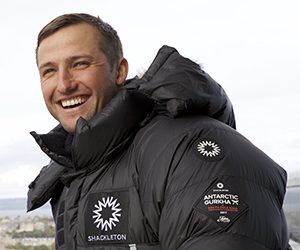 Route: Hercules Inlet – South Pole
Route: Hercules Inlet – South Pole
Skier: Scott Sears (UK)
In a bid to be the youngest person to ski solo, unsupported, and unassisted to the South Pole, Scott Sears set out from Hercules Inlet on November 17. An impressive forty days later, Scott finished his journey arriving at the South Pole on Christmas Day.
Scott serves as a lieutenant in the First Battalion Royal Gurkha Rifles. He has already raised well over 35,000 GBP for the Gurkha Welfare Trust.
Number of Days in Field: 40 days
Miles Skied: 702 miles (1130 km)
Learn More:
antarcticgurkha.com
YASUNAGA OGITA: SOUTH POLE EXPEDITION 2017
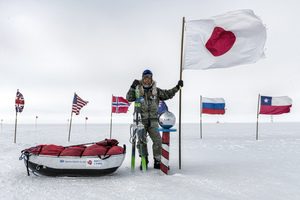
Route: Hercules Inlet – South Pole
Skier: Yasunaga Ogita (Japan)
Touting an impressive resume of more than 15 Arctic trips and numerous solo expeditions, Yasunaga Ogita decided to shake things up this season and head south. He hoped to become the first Japanese explorer to reach the South Pole solo, unsupported, and unassisted. He began his journey at Hercules Inlet and successfully completed his objective on January 5.
Through the 100 Miles Adventure Project, Yasu hopes to continue sharing his polar experiences with children in order to bring them joy and a wider perspective of the world around them.
Number of Days in Field: 50 days
Miles Skied: 702 miles (1130 km)
Learn More:
polar-ogita.com
ogita-exp.com
ALE Ski South Pole Expedition
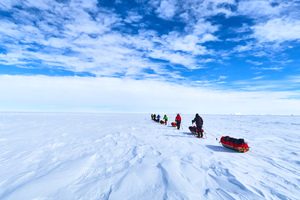
Route: Hercules Inlet – South Pole
Skiers: Anne-Elisabeth Eskerud (Norway), Jon Erik Thunold (Norway), Angelo Felgueiras (Portugal), David Woodman (UK), Ali Negyal (UK), Christian Styve (Norway, Guide), Carl Alvey (UK, Guide)
ALE’s Ski South Pole-Hercules Inlet team began with five guests skiing alongside ALE guides Carl Alvey and Christian Styve. The team received three resupplies along the 700 mile (1126 km) route and anticipated reaching the South Pole by mid-January.
Facing harsh conditions and with some team members struggling from physical ailments, the difficult decision was made to split the team. One team member returned to Union Glacier, while Carl skied on towards the South Pole with three team members. Christian and the remaining team member were airlifted forward to 89° South and skied the Last Degree to the South Pole.
This was Carl’s ninth Antarctic summer season and his fourth Ski South Pole expedition. Christian returned to Antarctica for his second summer season and his first Ski South Pole expedition.
Number of Days in Field: 55 days
Miles Skied: 702 miles (1130 km)
Learn More:
facebook.com/antarcticlogistics
instagram.com/antarcticlogistics
twitter.com/Antarctic_ALE
South Pole Energy Challenge
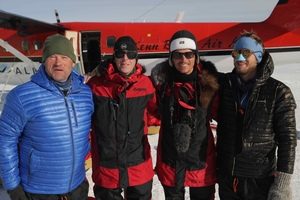
Route: Messner Start – South Pole
Skiers: Robert Swan (UK), Barnaby Swan (UK), Kyle O’Donoghue (Ireland), Martin Barnett (USA, Guide)
The 2041 ClimateForce team, comprised of father/son duo Robert and Barney Swan and videographer Kyle O’Donoghue, teamed up with ALE Guide Martin Barnett in an effort to reach the South Pole using only renewable energy sources. The team traveled 566 miles (911 km) from the Messner Start on the Ronne-Filchner Ice Shelf to the South Pole with two resupplies.
Robert returned to Union Glacier from Thiel Corner, while the remaining team members continued on. They were then reunited with Robert at 89° South, when he and a group of 2041 Ski Last Degree expeditioners joined them for the final 60 nautical miles.
The entire team arrived at the South Pole on January 16, 56 days after setting out.
Robert Swan was the first person to ski to both North and South Poles. His epic ‘Footsteps of Scott’ expedition (1984-87), with Gareth Wood and Roger Mear, was the first modern-day ski expeditions to the South Pole. Since 1992 he has worked as a tireless advocate for the protection of Antarctica.
Number of Days in Field: 56 days
Miles Skied: 566 miles (911 km)
Learn More:
2041.com
Polar Consultants Ski South Pole Expedition
 Route: Hercules Inlet – South Pole
Route: Hercules Inlet – South Pole
Skiers: Jing Feng (China), Paul Landry (Canada, Guide)
Polar Consultants’ Ski South Pole-Hercules Inlet team was a small but sturdy crew. Jin Feng and guide Paul Landry skied over 700 miles (1126 km) from Hercules Inlet to the South Pole, receiving three resupplies along the way. By successfully completing her journey, Jing became the first Chinese woman to ski to the South Pole from Hercules Inlet.
Jing was inspired by Felicity Aston, the first woman to ski alone across Antarctica, and decided to plan her own expedition. Her preparation included learning to ski as well as running a half marathon nearly every day. Paul is an experienced polar explorer with multiple trips to the South Pole, North Pole, and across the Greenland icecap. At 62, he is the oldest person to guide a ski expedition to the South Pole.
Number of Days in Field: 52 days
Miles Skied: 702 miles (1130 km)
Learn More:
polarconsultants.com
Polar Dream: First Croatian Expedition to the South Pole
 Route: Hercules Inlet – South Pole
Route: Hercules Inlet – South Pole
Skier: Davor Rostuhar (Croatia)
Davor embarked on a solo, unsupported, and unassisted expedition from Hercules Inlet to the South Pole and became the first Croatian to complete this trek. He maximized the educational impact of his expedition by arriving at the South Pole after the Christmas holidays, when Croatian school children were back at school.
Davor is no stranger to expeditions in remote parts of the world. He is a freelance artist and writer, documenting traditional cultures of the Arctic.
Number of Days in Field: 49 days
Miles Skied: 702 miles (1130 km)
Learn More:
kek.hr
Ice Trek: South Pole via Kansas Glacier
 Route: Ross Ice Shelf – Reedy/Kansas Glacier – South Pole
Route: Ross Ice Shelf – Reedy/Kansas Glacier – South Pole
Skiers: Jade Hameister (Australia), Paul Hameister (Australia), Ming D’Arcy (Australia), Heath Jamieson (Australia, Guide), Eric Philips (Australia, Guide)
Ice Trek’s five-person team was made up of father/daughter team Paul and Jade, cameraman Ming, and Ice Trek Guides Heath and Eric. The team’s objective was to complete a partial new route from the Ross Ice Shelf to the South Pole via both the Reedy and Kansas Glaciers, without resupplies. Jade, who had already completed a Last Degree expedition to the North Pole and an expedition in Greenland, hoped to become the youngest woman to ski to the South Pole.
The team endured harsh conditions and freezing temperatures while skiing the nearly 400 mile (643 km) route. Despite the extreme cold, they reached the South Pole unsupported and unassisted just 37 days after setting out.
Eric is an experienced polar expedition leader and guide, who has worked in the Arctic and Antarctic for more than 20 years. He has led expeditions on the Arctic Ocean, Antarctica, Greenland, Iceland, Svalbard, and the South Patagonia Icecap.
Number of Days in Field: 37 days
Miles Skied: 362 miles (582 km)
Learn More:
icetrek.com/iceblog
jadehameister.com
Mountaineering Expeditions
Spectre Expedition
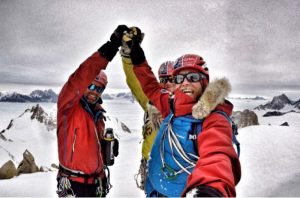 Route: 88⁰ S, 110⁰ W – Organ Pipe Peaks – Ross Ice Shelf – Union Glacier
Route: 88⁰ S, 110⁰ W – Organ Pipe Peaks – Ross Ice Shelf – Union Glacier
Climbers: Jean Burgun (France), Mark Sedon (New Zealand), Leo Houlding (UK, Expedition Leader)
The Spectre team was undaunted by the remoteness of the Gothic Range and the logistical challenges of getting there by plane. They elected to be dropped off as close to their climbing objectives as logistics and budget would allow. As a result, their expedition began at 88⁰S, 110⁰W, aka the middle of nowhere. From there, the team kite skied almost 200 miles (303 km) to reach the Organ Pipe Peaks, where they established a base camp at the base of the Spectre (6,630 ft or 2020 m).
Initially hunkered down by bad weather, the team was able to make their move on December 10. Their original intent had been to climb a new route on the South Buttress. After assessing the options and realizing they lacked sufficient big wall equipment and time, they decided that their primary objective should be to get to the summit via the north face, loosely following the original Mugs and Edmund Stump route. 21 hard-earned hours of climbing later, they completed the second ascent of the Spectre. It had been 37 years since someone stood atop the peak.
The team then attempted a skyline traverse of the Organ Pipe Peaks. They successfully reached the summit of Tower A before being turned around by weather.
Having reached most of their summit objectives, the team began their 1,000 mile (1905 km) journey back to Union Glacier. This portion of their expedition took just under a month of kite skiing and man-hauling the sleds. The key achievement of the expedition was to travel long distances to and from their objective using the latest ski and kite technology. In doing so they proved that upwind kite travel is possible with the right equipment.
Number of Days in Field: 50 days
Miles Skied/Kited: 1,372 miles (2208 km)
Learn More:
spectreexpedition.com
community.berghaus.com
NO MAN’S LAND: EXPEDITION ANTARCTICA
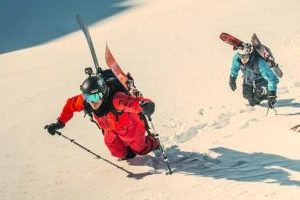 Route: Union Glacier – South Sentinel Range – Union Glacier
Route: Union Glacier – South Sentinel Range – Union Glacier
Climbers: Matthias Mayr (Austria), Jakob “Hauni” Haunholder (Austria), Johannes Aitzetmuller (Austria)
Matthias and Hauni teamed up with cinematographer Johannes in search of peaks over 4,000 meters and the best freeride descents in Antarctica. The men kite-skied from Union Glacier to the southern peaks of the Heritage Range, Ellsworth Mountains, where they set up a base camp and built an igloo to protect against the harsh Antarctic weather.
After skiing some extraordinary lines around Mount Sporli, the men made the return journey to Union Glacier.
Matthias and Hauni have explored freeride descents in other remote areas, including an expedition to ski the highest peak in Eastern Siberia. The subsequent movie, The White Maze, won numerous awards. A new film No Man’s Land, based on their Antarctic expedition, will be released in late 2018.
Number of Days in Field: 8 days
Miles Skied: 28 miles (45 km)
Learn More:
bmw-mountains.com/en/no-mans-land
GMHM

Route: Pirrit Hills – Union Glacier
Climbers: Arnaud Bayol (France), Antoine Bletton (France), Jean-Yves Igonenc (France), Didier Jourdain (France), Sebastien Moatti (France), Dimitry Munoz (France)
The Group Militaire de Haute Montagne (GMHM) has made several previous visits to Antarctica. This season they headed to the Pirrit Hills, a group of rocky peaks south of the Ellsworth Mountains, hoping to establish new routes. With only seven days to climb, the group split into two teams. One team climbed a new route on the east Pillar of Mount Turcotte, while the other summited Mount Tidd via an unclimbed ice couloir protected by granite towers. Later the team successfully attempted summits of Mount Goodwin and again tried to summit Mount Tidd via the north face. Despite this North line not being successful, another group was able to reach the summit of Tidd via a SW ridge.
Having met their objectives and with no time remaining, the team packed up and headed back to Union Glacier via kite skiing.
The Group Militaire de Haute Montagne (GMHM) is an elite French military unit that specializes in mountaineering. They have an impressive list of Antarctic achievements, including a ski expedition to the South Pole from Berkner Island, a new route on Mt Tyree (15,919 ft or 4852 m) in 1997, and other first ascents in the Sentinel Range. Their personnel often include some of the most accomplished alpinists in France.
Number of Days in Field: 11 days
Miles Skied/Kited: 97 miles (156 km)
Learn More:
gmhm.fr
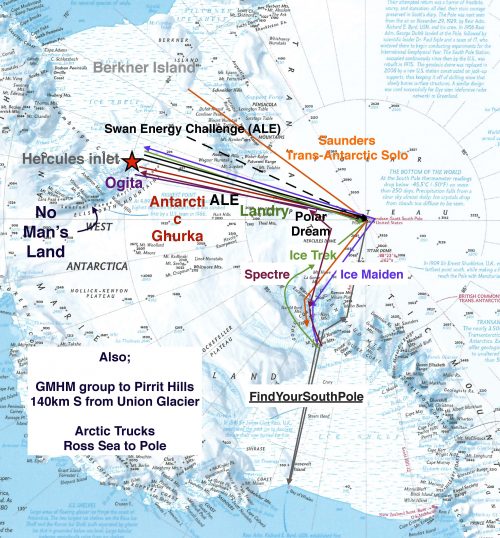 *ALE defines unsupported expeditions as those that start the expedition with all the equipment and supplies for the whole journey. They have no pre-placed depots, no resupplies, no support vehicles, and receive no outside help.
*ALE defines unsupported expeditions as those that start the expedition with all the equipment and supplies for the whole journey. They have no pre-placed depots, no resupplies, no support vehicles, and receive no outside help.
**ALE defines unassisted expeditions as those that are human powered and do not use external power aids for significant speed and load advantage. Assisted Antarctic expeditions typically use wind power (kites and ski-sails) or engine power (motorized vehicles).